engine HONDA CR-V 2000 RD1-RD3 / 1.G Owner's Guide
[x] Cancel search | Manufacturer: HONDA, Model Year: 2000, Model line: CR-V, Model: HONDA CR-V 2000 RD1-RD3 / 1.GPages: 322, PDF Size: 4.64 MB
Page 223 of 322
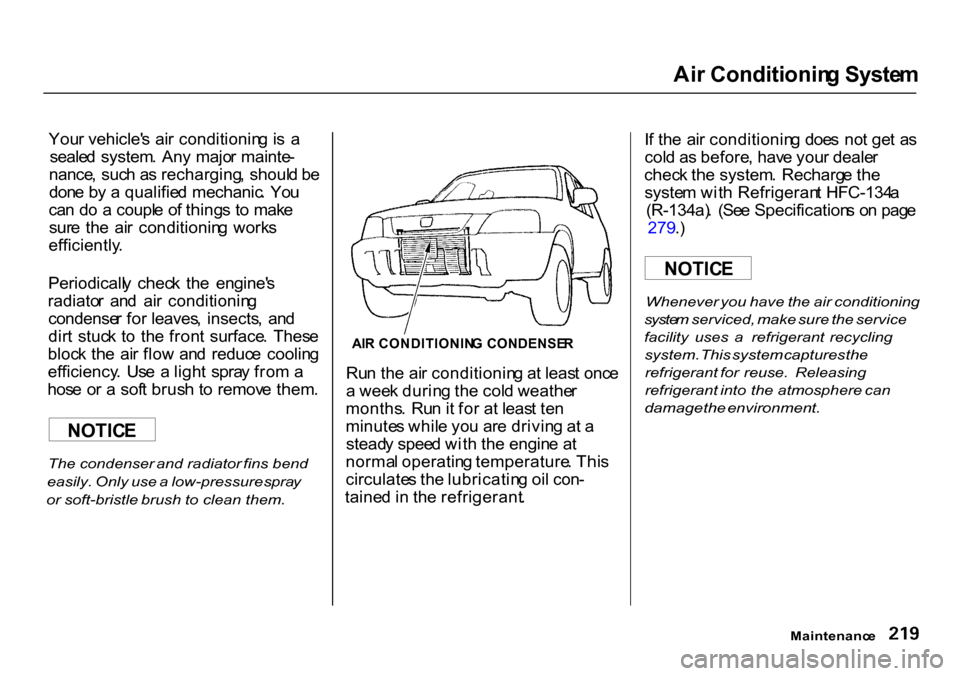
Ai
r Conditionin g Syste m
You r vehicle' s ai r conditionin g is a
seale d system . An y majo r mainte -
nance , suc h a s recharging , shoul d b e
don e b y a qualifie d mechanic . Yo u
ca n d o a coupl e o f thing s t o mak e
sur e th e ai r conditionin g work s
efficiently .
Periodicall y chec k th e engine' s
radiato r an d ai r conditionin g
condense r fo r leaves , insects , an d
dir t stuc k t o th e fron t surface . Thes e
bloc k th e ai r flo w an d reduc e coolin g
efficiency . Us e a ligh t spra y fro m a
hos e o r a sof t brus h t o remov e them .
The condenser and radiator fins bend
easily. Only use a low-pressure spray
or soft-bristle brush to clean them.
AI
R CONDITIONIN G CONDENSE R
Ru n th e ai r conditionin g a t leas t onc e
a wee k durin g th e col d weathe r
months . Ru n it fo r a t leas t te n
minute s whil e yo u ar e drivin g a t a
stead y spee d wit h th e engin e a t
norma l operatin g temperature . Thi s
circulate s th e lubricatin g oi l con -
taine d in th e refrigerant . I
f th e ai r conditionin g doe s no t ge t a s
col d a s before , hav e you r deale r
chec k th e system . Recharg e th e
syste m wit h Refrigeran t HFC-134 a
(R-134a) . (Se e Specification s o n pag e
279 .)
Whenever you have the air conditioning
syste m serviced, make sure the service
facility uses a refrigerant recycling
system. This system captures the
refrigerant for reuse. Releasing
refrigerant into the atmosphere can
damage the environment.
Maintenance
NOTIC
E
NOTIC E
Page 237 of 322
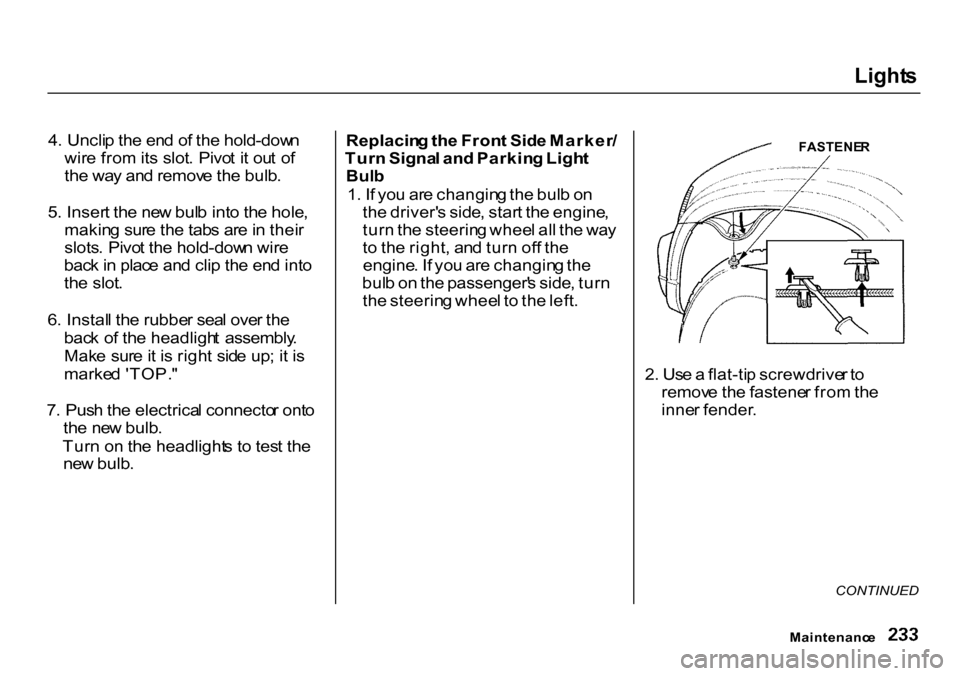
Light
s
4 . Uncli p th e en d o f th e hold-dow n
wir e fro m its slot . Pivo t i t ou t o f
th e wa y an d remov e th e bulb .
5 . Inser t th e ne w bul b int o th e hole ,
makin g sur e th e tab s ar e in thei r
slots . Pivo t th e hold-dow n wir e
bac k in plac e an d cli p th e en d int o
th e slot .
6 . Instal l th e rubbe r sea l ove r th e
bac k o f th e headligh t assembly .
Mak e sur e it i s righ t sid e up ; i t i s
marke d 'TOP. "
7 . Pus h th e electrica l connecto r ont o
th e ne w bulb .
Tur n o n th e headlight s t o tes t th e
ne w bulb . Replacin
g th e Fron t Sid e Marker /
Tur n Signa l an d Parkin g Ligh t
Bul b
1 . I f yo u ar e changin g th e bul b o n
th e driver' s side , star t th e engine ,
tur n th e steerin g whee l al l th e wa y
t o th e right , an d tur n of f th e
engine . I f yo u ar e changin g th e
bul b o n th e passenger' s side , tur n
th e steerin g whee l t o th e left .
FASTENE
R
2 . Us e a flat-ti p screwdrive r t o
remov e th e fastene r fro m th e
inne r fender .
CONTINUED
Maintenanc e
Page 262 of 322
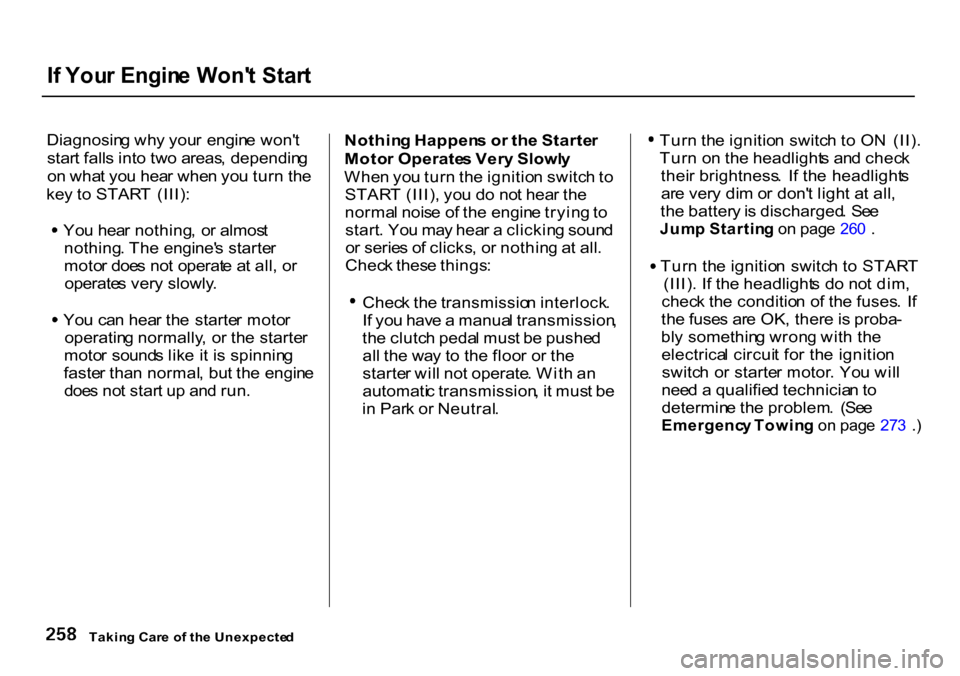
I
f You r Engin e Won' t Star t
Diagnosin g wh y you r engin e won' t
star t fall s int o tw o areas , dependin g
o n wha t yo u hea r whe n yo u tur n th e
ke y t o STAR T (III) :
Yo u hea r nothing , o r almos t
nothing . Th e engine' s starte r
moto r doe s no t operat e a t all , o r
operate s ver y slowly .
Yo u ca n hea r th e starte r moto r
operatin g normally , o r th e starte r
moto r sound s lik e i t i s spinnin g
faste r tha n normal , bu t th e engin e
doe s no t star t u p an d run . Nothin
g Happen s o r th e Starte r
Moto r Operate s Ver y Slowl y
Whe n yo u tur n th e ignitio n switc h to
STAR T (III) , yo u d o no t hea r th e
norma l nois e o f th e engin e tryin g to
start . Yo u ma y hea r a clickin g soun d
o r serie s o f clicks , o r nothin g a t all .
Chec k thes e things :
Chec k th e transmissio n interlock .
I f yo u hav e a manua l transmission ,
th e clutc h peda l mus t b e pushe d
al l th e wa y t o th e floo r o r th e
starte r wil l no t operate . Wit h a n
automati c transmission , i t mus t b e
i n Par k o r Neutral . Tur
n th e ignitio n switc h t o O N (II) .
Tur n o n the headlight s an d chec k
thei r brightness . I f th e headlight s
ar e ver y di m o r don' t ligh t a t all ,
th e batter y is discharged . Se e
Jum p Startin g o n pag e 26 0 .
Tur n th e ignitio n switc h t o STAR T
(III) . I f th e headlight s d o no t dim ,
chec k th e conditio n o f th e fuses . I f
th e fuse s ar e OK , ther e is proba -
bl y somethin g wron g wit h th e
electrica l circui t fo r th e ignitio n
switc h o r starte r motor . Yo u wil l
nee d a qualifie d technicia n to
determin e th e problem . (Se e
Emergenc y Towin g o n pag e 27 3 . )
Takin g Car e o f th e Unexpecte d
Page 263 of 322
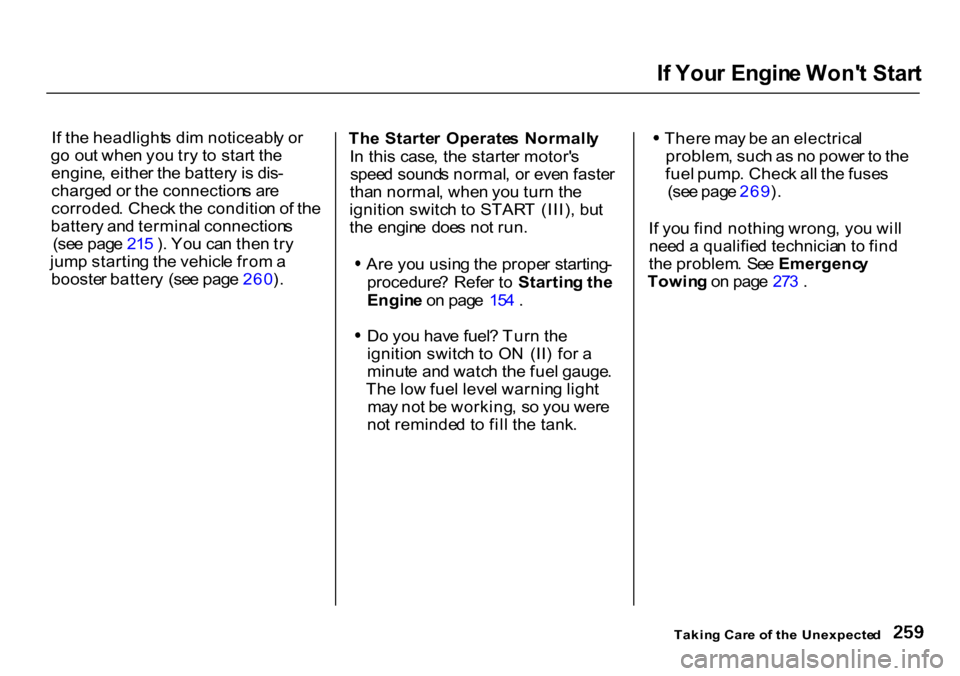
I
f You r Engin e Won' t Star t
I f th e headlight s di m noticeabl y o r
g o ou t whe n yo u tr y t o star t th e
engine , eithe r th e batter y i s dis -
charge d o r th e connection s ar e
corroded . Chec k th e conditio n o f th e
batter y an d termina l connection s
(se e pag e 21 5 ) . Yo u ca n the n tr y
jum p startin g th e vehicl e fro m a
booste r batter y (se e pag e 260 ). Th
e Starte r Operate s Normall y
I n thi s case , th e starte r motor' s
spee d sound s normal , o r eve n faste r
tha n normal , whe n yo u tur n th e
ignitio n switc h t o STAR T (III) , bu t
th e engin e doe s no t run .
Ar e yo u usin g th e prope r starting -
procedure ? Refe r t o Startin g th e
Engin e o n pag e 15 4 .
D o yo u hav e fuel ? Tur n th e
ignitio n switc h t o O N (II ) fo r a
minut e an d watc h th e fue l gauge .
Th e lo w fue l leve l warnin g ligh t
ma y no t b e working , s o yo u wer e
no t reminde d t o fil l th e tank . Ther
e ma y b e a n electrica l
problem , suc h a s n o powe r t o th e
fue l pump . Chec k al l th e fuse s
(se e pag e 269 ).
I f yo u fin d nothin g wrong , yo u wil l
nee d a qualifie d technicia n t o fin d
th e problem . Se e Emergenc y
Towin g o n pag e 27 3 .
Takin g Car e o f th e Unexpecte d
Page 265 of 322
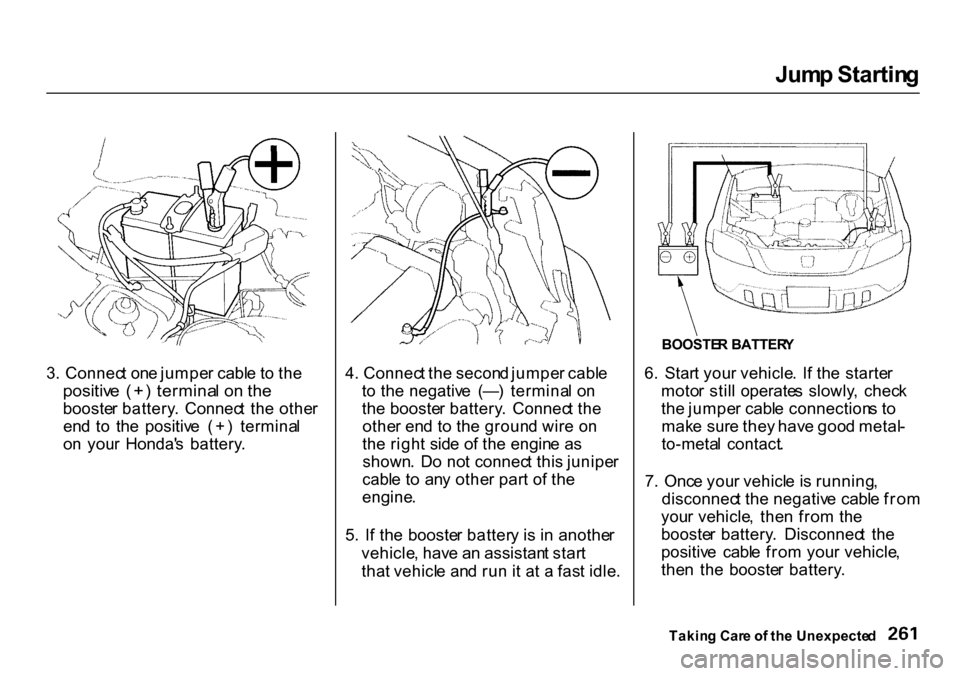
Jum
p Startin g
3 . Connec t on e jumpe r cabl e t o th e
positiv e (+ ) termina l o n th e
booste r battery . Connec t th e othe r
en d t o th e positiv e (+ ) termina l
o n you r Honda' s battery . 4
. Connec t th e secon d jumpe r cabl e
t o th e negativ e (— ) termina l o n
th e booste r battery . Connec t th e
othe r en d t o th e groun d wir e o n
th e righ t sid e o f th e engin e a s
shown . D o no t connec t thi s junipe r
cabl e t o an y othe r par t o f th e
engine .
5 . I f th e booste r batter y i s i n anothe r
vehicle , hav e a n assistan t star t
tha t vehicl e an d ru n i t a t a fas t idle . BOOSTE
R BATTER Y
6 . Star t you r vehicle . I f th e starte r
moto r stil l operate s slowly , chec k
th e jumpe r cabl e connection s t o
mak e sur e the y hav e goo d metal -
to-meta l contact .
7 . Onc e you r vehicl e is running ,
disconnec t th e negativ e cabl e fro m
you r vehicle , the n fro m th e
booste r battery . Disconnec t th e
positiv e cabl e fro m you r vehicle ,
the n th e booste r battery .
Takin g Car e o f th e Unexpecte d
Page 266 of 322

I
f You r Engin e Overheat s
Th e pointe r o f you r vehicle' s
temperatur e gaug e shoul d sta y in
th e midrang e unde r mos t conditions .
I t ma y g o highe r i f yo u ar e drivin g u p
a lon g stee p hil l o n a ver y ho t day . I f
i t climb s t o th e re d mark , yo u shoul d
determin e th e reason .
Driving with the temperature gauge
pointer at the red mark can cause
serious damage to your engine.
You r vehicl e ca n overhea t fo r severa l
reasons , suc h a s lac k o f coolan t o r a
mechanica l problem . Th e onl y
indicatio n ma y b e th e temperatur e
gaug e climbin g to o r abov e th e re d
mark . O r yo u ma y se e stea m or
spra y comin g fro m unde r th e hood .
I n eithe r case , yo u shoul d tak e
immediat e action .
1
. Safel y pul l t o th e sid e o f th e road .
Pu t th e transmissio n in Neutra l o r
Par k an d se t th e parkin g brake .
Tur n of f th e heatin g an d coolin g
syste m an d al l othe r accessories .
Tur n o n th e hazar d warnin g
indicators .
2 . I f yo u se e stea m and/o r spra y
comin g fro m unde r th e hood , tur n
of f th e engine . 3
. I f yo u d o no t se e stea m o r spray ,
leav e th e engin e runnin g an d
watc h th e temperatur e gauge . I f
th e hig h hea t i s du e t o overloadin g
(climbin g a long , stee p hil l o n a
ho t da y wit h th e A/ C running , fo r
example) , th e engin e shoul d star t
t o coo l dow n almos t immediately .
I f i t does , wai t unti l th e tempera -
tur e gaug e come s dow n t o th e mid -
poin t the n continu e driving .
4 . I f th e temperatur e gaug e stay s a t
th e re d mark , tur n of f th e engine .
5 . Wai t unti l yo u se e n o mor e sign s
o f stea m o r spray , the n ope n th e
hood .
Takin g Car e o f th e Unexpecte d
NOTIC
E
Stea
m an d spra y fro m a n
overheate d engin e ca n
seriousl y scal d you .
D o no t ope n th e hoo d i f stea m
i s comin g out .
Page 268 of 322
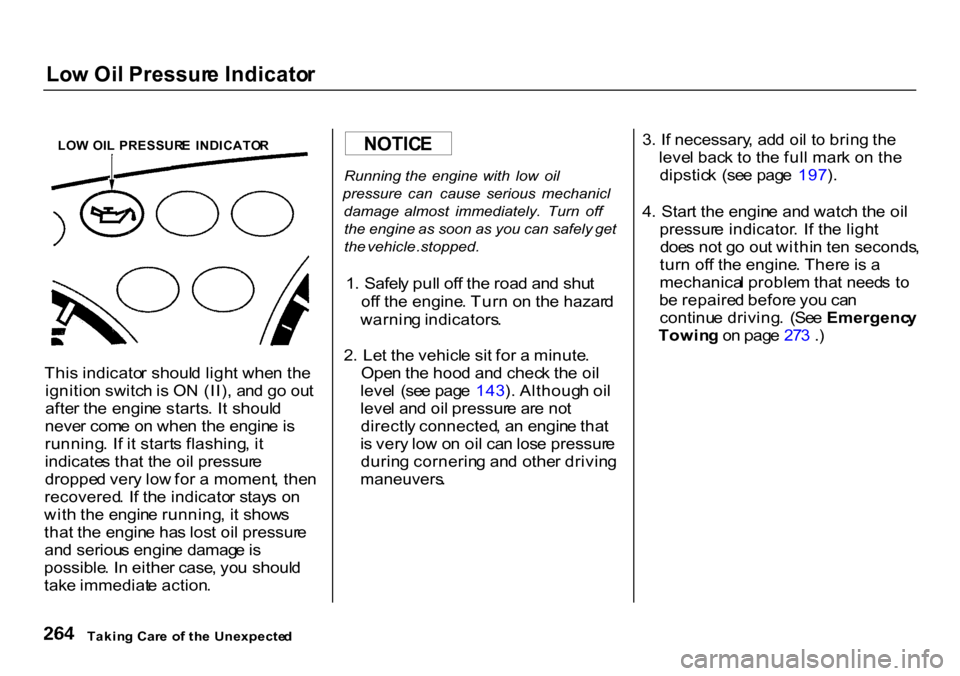
Lo
w Oi l Pressur e Indicato r
LO W OI L PRESSUR E INDICATO R
Thi s indicato r shoul d ligh t whe n th e
ignitio n switc h is O N (II) , an d g o ou t
afte r th e engin e starts . I t shoul d
neve r com e o n whe n th e engin e is
running . I f i t start s flashing , i t
indicate s tha t th e oi l pressur e
droppe d ver y lo w fo r a moment , the n
recovered . I f th e indicato r stay s o n
wit h th e engin e running , i t show s
tha t th e engin e ha s los t oi l pressur e
an d seriou s engin e damag e is
possible . I n eithe r case , yo u shoul d
tak e immediat e action . Running
the engine with low oil
pressure can cause serious mechanicl
damage almost immediately. Turn off
the engine as soon as you can safely get
the vehicle .stopped.
1 . Safel y pul l of f th e roa d an d shu t
of f th e engine . Tur n o n th e hazar d
warnin g indicators .
2 . Le t th e vehicl e si t fo r a minute .
Ope n th e hoo d an d chec k th e oi l
leve l (se e pag e 143 ). Althoug h oi l
leve l an d oi l pressur e ar e no t
directl y connected , a n engin e tha t
i s ver y lo w o n oi l ca n los e pressur e
durin g cornerin g an d othe r drivin g
maneuvers .
3
. I f necessary , ad d oi l t o brin g th e
leve l bac k t o th e ful l mar k o n th e
dipstic k (se e pag e 197 ).
4 . Star t th e engin e an d watc h th e oi l
pressur e indicator . I f th e ligh t
doe s no t g o ou t withi n te n seconds ,
tur n of f th e engine . Ther e is a
mechanica l proble m tha t need s t o
b e repaire d befor e yo u ca n
continu e driving . (Se e Emergenc y
Towin g o n pag e 27 3 .)
Takin g Car e o f th e Unexpecte d
NOTIC
E
Page 270 of 322
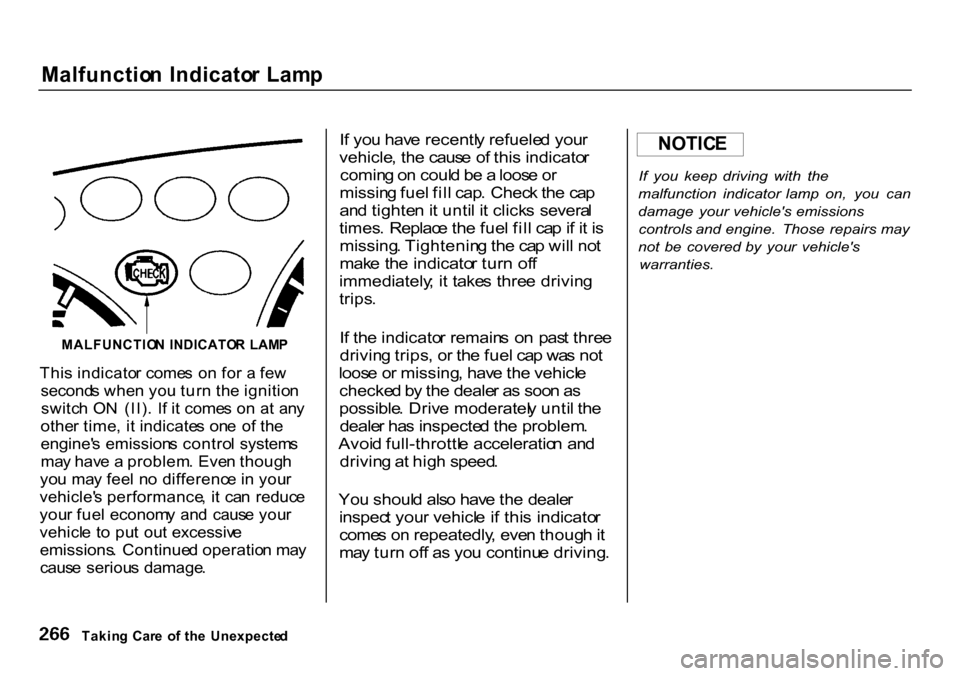
Malfunctio
n Indicato r Lam p
Thi s indicato r come s o n fo r a fe w
second s whe n yo u tur n th e ignitio n
switc h O N (II) . I f i t come s o n a t an y
othe r time , i t indicate s on e o f th e
engine' s emission s contro l system s
ma y hav e a problem . Eve n thoug h
yo u ma y fee l n o differenc e in you r
vehicle' s performance , i t ca n reduc e
you r fue l econom y an d caus e you r
vehicl e t o pu t ou t excessiv e
emissions . Continue d operatio n ma y
caus e seriou s damage .
I
f yo u hav e recentl y refuele d you r
vehicle , th e caus e o f thi s indicato r
comin g o n coul d b e a loos e o r
missin g fue l fil l cap . Chec k th e ca p
an d tighte n it unti l i t click s severa l
times . Replac e th e fue l fil l ca p if i t i s
missing . Tightenin g th e ca p wil l no t
mak e th e indicato r tur n of f
immediately ; i t take s thre e drivin g
trips .
I f th e indicato r remain s o n pas t thre e
drivin g trips , o r th e fue l ca p wa s no t
loos e o r missing , hav e th e vehicl e
checke d b y th e deale r a s soo n a s
possible . Driv e moderatel y unti l th e
deale r ha s inspecte d th e problem .
Avoi d full-throttl e acceleratio n an d
drivin g a t hig h speed .
Yo u shoul d als o hav e th e deale r
inspec t you r vehicl e if thi s indicato r
come s o n repeatedly , eve n thoug h it
ma y tur n of f a s yo u continu e driving .If
you keep driving with the
malfunction indicator lamp on, you can
damage your vehicle's emissions
controls and engine. Those repairs may
not be covered by you r vehicle's
warranties.
Takin g Car e o f th e Unexpecte d
MALFUNCTIO
N INDICATO R LAM P NOTIC
E
Page 282 of 322
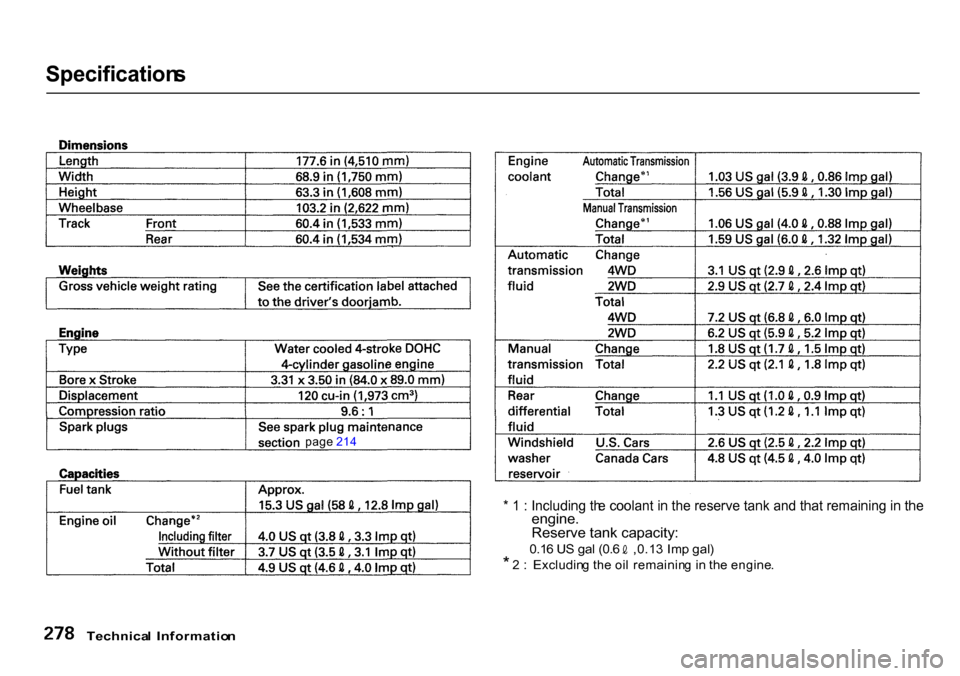
Specification
s
Technica l Informatio n
page
214
* 1 : Including the coolant in the reserve tank and that remaining in the
engine.
Reserve tank capacity:
0.1
6 U S ga l (0. 6 ,0.1 3 Im p gal )
* 2 : Excludin g th e oi l remainin g i n th e engine .
Page 288 of 322

Emission
s Control s
Th e burnin g o f gasolin e i n you r
vehicle' s engin e produce s severa l by -
products . Som e o f thes e ar e carbo n
monoxid e (CO) , oxide s o f nitroge n
(NOx ) an d hydrocarbon s (HC) .
Gasolin e evaporatin g fro m th e tan k
als o produce s hydrocarbons . Con -
trollin g th e productio n o f NOx , CO ,
an d H C is importan t t o th e environ -
ment . Unde r certai n condition s o f
sunligh t an d climate , NO x an d H C
reac t t o for m photochemica l "smog. "
Carbo n monoxid e doe s no t contri -
but e t o smo g creation , bu t i t i s a
poisonou s gas . Th
e Clea n Ai r Ac t
Th e Unite d State s Clea n Ai r Act *
set s standard s fo r automobil e
emissions . I t als o require s tha t
automobil e manufacturer s explai n t o
owner s ho w thei r emission s control s
wor k an d wha t t o d o t o maintai n
them . Thi s sectio n summarize s ho w
th e emission s control s work .
Schedule d maintenanc e is o n pag e
188 .
* I n Canada , Hond a vehicle s compl y
wit h th e Canadia n Moto r Vehicl e
Safet y Standard s (CMVSS ) fo r
Emission s vali d a t th e tim e the y ar e
manufactured .
Crankcas
e Emission s Contro l
Syste m
You r vehicl e ha s a Positiv e
Crankcas e Ventilatio n System . Thi s
keep s gasse s tha t buil d u p in th e
engine' s crankcas e fro m goin g int o
th e atmosphere . Th e Positiv e Crank -
cas e Ventilatio n valv e route s the m
fro m th e crankcas e bac k t o th e
intak e manifold . The y ar e the n
draw n int o th e engin e an d burned .
Evaporativ e Emission s Contro l
Syste m
A s gasolin e evaporate s i n th e fue l
tank , a n evaporativ e emission s
contro l caniste r fille d wit h charcoa l
adsorb s th e vapor . I t i s store d in thi s
caniste r whil e th e engin e is off . Afte r
th e engin e is starte d an d warme d up ,
th e vapo r i s draw n int o th e engin e
an d burne d durin g driving .
Technica l Informatio n